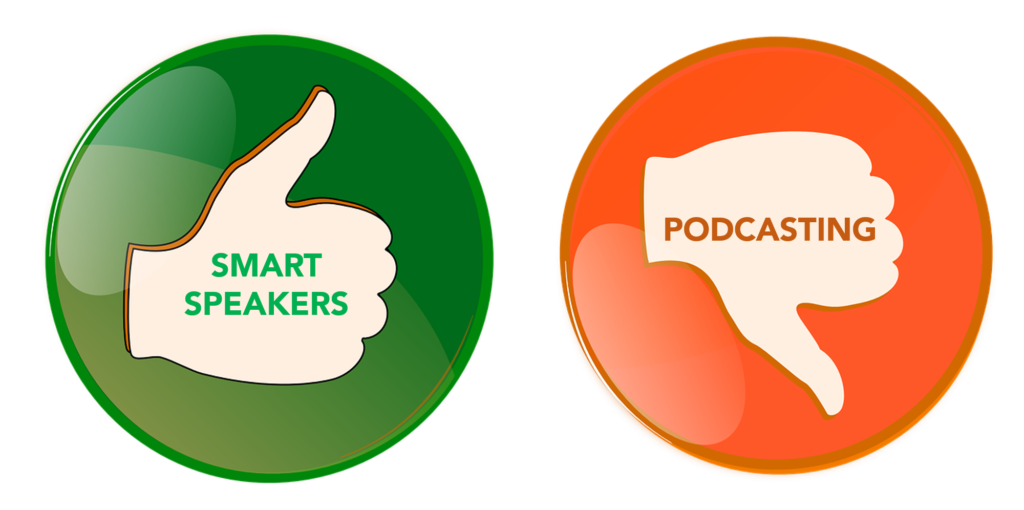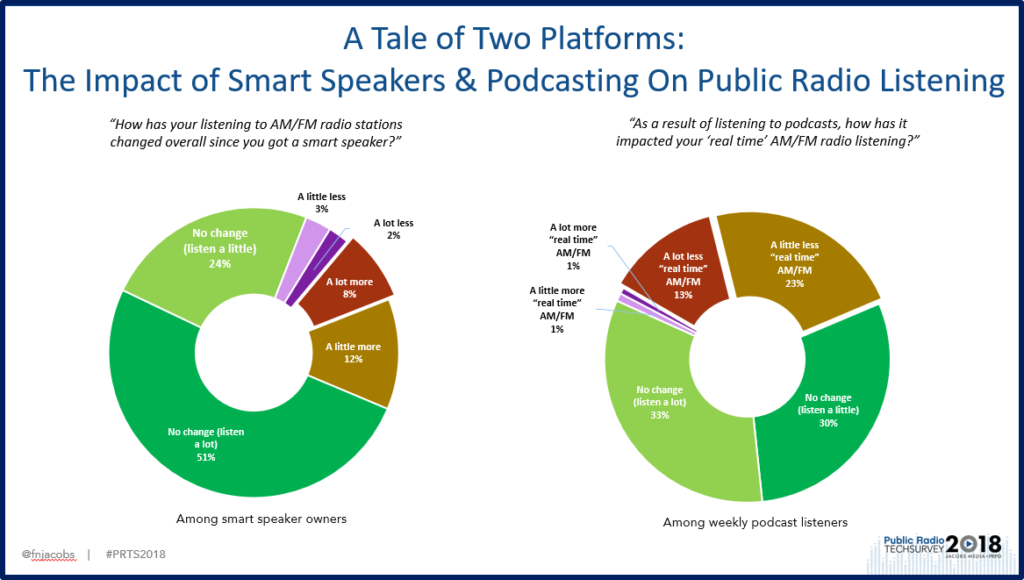
I have a fascinating perch in the radio industry. With a vast network of contacts – from CEOs to air personalities – and from attending more than a dozen conferences each year, from CES to Conclave – I get an amazing perspective on the media and technology worlds.
Last week, I had the privilege of attending and participating in the Public Radio Program Directors convention in Austin. This is a fascinating group – a melange of programmers representing news/talk, AAA, classical, as well as other diverse formats and specialty programs. By and large, public radio has had a great couple of years, bolstered in no small part by the frenetic news cycle. But I would argue that a primary reason why many public radio stations are thriving can be explained by an adherence to an ecosystem of core values established decades ago. Many public radio PDs still carry a laminated card in their wallets, listing the tenets that guide this system of radio outlets.
I love to listen at these events, taking notice of what people are talking about. And not unlike what I expect will be the case at the NAB Radio Show next month in Orlando, the two big topics at PRPD were podcasting and smart speakers.
And for good reason. Public radio has led the league in the podcasting arena. Most of the most popular podcasts week in and week out have public radio DNA of one kind or another. Whether they are repurposed programs or original content, public radio companies, networks, and stations are well out in front of the pack. This is one of the key reasons we led off our Broadcasters Meet Podcasters session at Podcast Movement last month with NPR CEO Jarl Mohn. Why not go to the very best in the media business to gain insights about what works – and what doesn’t?
Then there’s smart speakers. In every major web survey we conduct, these voice-activated cylinders and discs are showing iPhone-like growth. This is the case in Techsurvey (11%→21%), Public Radio Techsurvey (12%→20%), and our soon-to-be-released Christian Music Techsurvey (8%→16%). In an environment where most other technologies and media are up and down just incrementally, the rapid ascent of devices like Amazon Echo and Google Home are more than just noteworthy – they’re impressive and they demand our attention.
The truly good news is that while both the podcasting and smart speaker platforms provide challenges to broadcast radio stations of all stripes, they also represent vast opportunities. Radio producers, PDs, airstaffers, and content creators all have the ability to make and market content for both of these verticals, providing potential new avenues of listenership and monetization.
They are also interrelated. As more and more consumers become oriented to voice commands to call up content, the ability to pull up an episode of “Pod Save America” or “Bobbycast” via Alexa or Google Voice becomes more tangible and accessible every day. As we learned in all three surveys this year, the large number of people we refer to as “podcast nevers” – those who simply do not listen to podcasts – fall into this group because they struggle to overcome inherent speed bumps in both discovering and consuming on-demand audio.
Clearly, smart speakers can become that media gateway drug to increasing how people become oriented to – and ultimately hooked on – podcast shows.
But what are the net effects of consumers gravitating to these platforms? How do they impact broadcast radio listening? And how should heritage radio companies and groups address the opportunities and challenges presented by these technologies?
First and foremost, it’s important to realize what’s at stake here. Looking specifically at the recently released Public Radio Techsurvey 2018, it is truly a tale of two platforms. Those who are regular podcast listeners tell us two important things:
- For many, podcasts have an addictive quality. Once people get in the groove of listening to podcasts, it can become habit-forming.
- And looking at the net-net of podcasting on broadcast listening, many say that as a result of consuming podcasts, they’re listening to less traditional radio.
With smart speakers, it’s a very different story. Here are the salient facts that continue to emerge in all our Techsurveys about the newest voices in radio – like Alexa:
- Listening to AM/FM radio (music and talk) is a key use case for smart speaker owners. Along with asking these devices general questions and for weather updates, using them to “tune in” broadcast radio stations is a primary ask.
- And device owners tell us that as a result of acquiring a smart speaker(s), they are listening to more radio.
Demographics tell the story, too. In PRTS 2018, Millennials are the generational group most likely to spend more time with public radio stations when Amazon Echo or Google Home is in the house, the office, the dorm, or the garage. Interestingly, with podcasts, Millennials and Gen Xers are the two groups most apt to decrease their time with broadcast radio.
So, how to reconcile these differences when one new platform appears to be additive while the other is erosive?

Based on this data, you could make the case for going all-out into the world of Alexa and Google Voice, while steering clear of the podcast space. After all, great podcasts are difficult to produce, and there’s every chance they’ll cannibalize traditional radio listening. Alexa skills – while sometimes challenging – don’t necessarily require custom audio content.
But that logic would ignore what’s happening to that 800 pound canary in the Netflix coalmine – local television. The impact of on-demand video on broadcast and cable TV isn’t just notable – it’s been devastating. And it’s getting worse by the month. As consumers get more and more in the habit of accessing video content on demand, rather than having to wait for the 6pm news or “The Bachelorette,” TV ratings are cratering, showing no sign of a letup or a recovery.
Perhaps some of the bleeding could have been stopped if broadcast TV executives would have seen the video streaming revolution coming. In hindsight, they could have been far more proactive in making more and more of their content accessible on-demand, whether it’s entire programs, select news stories, or even custom-made video fans would enjoy.
But alas, they waited, ignoring YouTube’s rise (the channel has been around for 13 years now), and turning the other way when Netflix made the transition from sending out DVDs in the mail to streaming programming on demand with just a few clicks of the same remote that tuned in “Jeopardy” and “Shark Tank.”
For public radio operators – and I would argue commercial radio companies, too – it’s important to understand the countervailing effects of podcasting and smart speakers on broadcast radio listening. It’s paramount to draw up strategies for both platforms. When you’re looking at Techsurvey data, you’re studying a huge sample of core users – those who regularly listen to and (mostly) enjoy broadcast radio listening. When you see them move around as new ecosystems emerge and develop, you’d be wise to pay attention to these trends.
Creating relevant, compelling podcasts and on-demand programming is something every radio company must confront – or most certainly suffer the same fate radio’s TV bros are enduring. And in the smart speaker arena, learning about and developing voice strategies are prerequisites to making content available on these fast-growing new devices and technologies. Alexa isn’t a digital persona heard in a cylindrical device that sits on the kitchen island – it is a technology that is rapidly being baked into myriad gadgets – from refrigerators to home security systems to car dashboards.
Broadcasters – both public and commercials – are seeing impressive streaming numbers on smart speakers, often comprising significant percentages of listening. That will only rise as more and more of these gadgets end up at home, workplaces, and other locations.
Teaching consumers how to access your station’s content on the Echo and Google Voice ecospheres is quickly becoming the digital ante in a high stakes game where content and distribution are expanding in ways that were not happening just a few short years ago.
As we’ve learned during the past two decades or so, the ways in which technology giveth and taketh away are often unpredictable. But one thing we know for certain is that change and disruption are constants. They have defined this era of media, and will continue to do so.
We need to accept it, embrace it, and figure it out.
Right, Alexa?
- What To Do If Your Radio Station Goes Through A Midlife Crisis - April 25, 2025
- A 2020 Lesson?It Could All Be Gone In A Flash - April 24, 2025
- How AI Can Give Radio Personalities More…PERSONALITY - April 23, 2025




Great content Fred!
Thank you, Gene. Best to Julie.
I’m curious to get your analysis (subject of a future column?)of how podcasts are being successfully handled by music stations – especially public radio music formats (like jazz & AAA) where the whole service is more about the music itself than personalities. Smart speakers are definitely a plus for all of us, but music copyright rules present a huge roadblock for most podcasts actually containing more than short snippets of copyrighted music – and none of the top podcasts typically have anything to do with music as a regular topic. In-depth interviews for hardcore music fanatics (like the excellent “Questlove Suprema” on Pandora) are an option, but how much staff time/resources to devote? No one on the music side is trying to get left behind by podcasts but…
It’s a cononundrum, Dan. Unless you’re dealing with local bands with whom you can cut deals, you’re pretty much stuck with talking about music, rather than playing it. Keep in mind, there’s an entire SiriusXM channel that’s essentially doing just that – “music talk that rocks.” Not a perfect solution given your issue with staffing resources. And you don’t need to create 12 hours a day of programming. Appreciate the idea for a future post.